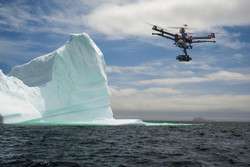New 'Arctic-proof' drone to track the effects of climate change

Drones generally get a bad press but there's far more to them than destruction and war – for example drone technology can help save lives in disaster zones reaching places that no humans can tread. Now researchers from Laval University in Canada have revealed another surprising and positive drone application – tracking the impact of climate change in the Arctic.
Laval University's Argo drone can survive in the extreme conditions of the Arctic Ocean, plunging depths of almost 2 000 metres to collect data about marine organisms. This means that it can collect previously inaccessible information to improve our understanding of the Arctic marine ecosystem and track the effects of climate change.
The Argo drone is a few years in the making – in 2000, the UNESCO Intergovernmental Oceanographic Commission and the World Meteorological Organisation launched the Argo programme with the aim of creating a global network of beacons for an integrated global ocean observing system. Now there are thousands of Argo 'floats' or drones in our oceans however the unforgiving conditions in the Arctic mean that it hosts very few, as Brigitte Robineau, executive director of Québec-Océan explains: 'There are now nearly 4,000 Argo floats deployed in the oceans. However, because of the constraints imposed by the cold sea ice and icebergs, there are very few in the Arctic Ocean. As these instruments can provide valuable data to researchers who conduct work, the team of Marcel Babin and Claudie Marec undertook the design and manufacture of a float adapted to this environment.'
According to José Lagunas-Morales, a specialist embedded systems engineer on the project, the main challenge was to protect the drone from the threat posed by ice. The drone actually spends most of its time under water but it is when it surfaces and possibly collides with ice that the telecommunications equipment, temperature sensors or other equipment could get damaged. Or it could become trapped by the ice – which would be very costly. Lagunas-Morales notes, 'We have to avoid the device getting trapped in ice because it would then become useless for research. Any error in design or programming could be very costly, literally and figuratively, since each tag is worth about $90 000 (EUR 80 300).'
With this in mind, Lagunas-Morales developed an optical system which allows Argo to detect the presence of ice: 'When it nears the surface, it emits a laser beam and the reflected light is collected and analyzed which allows it to distinguish the ice-free water. The float needs only 1 metre squared of free water to the surface, but we programmed it with a safety margin of 3 metre squared.'
It has already been tested in the waters of Baffin Bay, located between Baffin Island and the southwest coast of Greenland. According to the University of Laval, if the tests are successful, four Argo floats equipped with this optical ice detection system will be deployed in the Arctic Ocean in the coming months. Within three years, it is expected that researchers will be able to rely on data from an armada of 23 devices. The drone has an impressive 'battery life' of four years. As engadget notes, 'If everything goes well, however, the drone will be tracking the biological effects of climate change within a matter of months.'
Provided by CORDIS




















